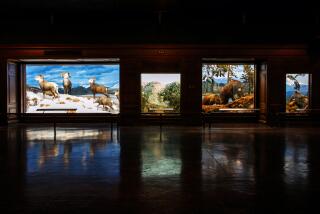Creating a slice of hog heaven
MILWAUKEE — One STEP closer. That was the guiding principle in developing the new Harley-Davidson Museum, opening this week.
“If you’re a hard-core enthusiast, you ought to get more enthusiastic,” curatorial director Jim Fricke said. “If you’re convinced that motorcycles are evil, hopefully you leave hating them a little less.”
Regardless of their feelings about motorcycles generally or Harley-Davidson in particular, visitors will likely be impressed, if only by the stunning steel-girder architecture rising from a former brownfield site on Milwaukee’s south side. The trio of gunmetal-gray buildings stand like a beacon, beckoning passers-by with the raw but highly stylized materials of brick, glass and metal. They meld together in the new museum, creating a factory feel that pays tribute to its namesake’s manufacturing focus as well as Milwaukee’s industrial past.
The new $75-million complex is the latest example of a vast and predominantly privately funded revitalization of Milwaukee in recent years. Miller Park stadium, the Discovery World technology museum and the Santiago Calatrava-designed expansion of the Milwaukee Art Museum have all opened since 2001, representing a $600-million civic investment. To walk the museum floors (tickets, $10 to $16) is to witness the evolution of motorcycles -- from blase-colored bicycles with strapped-on fuel tanks to chromed and stretched customs with enormous engines and outrageous paint -- and to sense important changes in broad American culture.
Motorcyclists are clearly the target audience for the new 20-acre attraction, which was privately funded by the 105-year-old company. The “streets” leading up to the three buildings are striped with Harley’s signature color -- orange -- and are 60 feet wide so the many bikers who’ll make pilgrimages here can park “Sturgis style,” with one motorcycle on each curb and two parked in the center. The idea is that the museum experience starts on the street, when riders kick down their side stands and check out one another’s machines. Pull open the tall, metal doors of the museum’s entrance and the shadow of a bike beckons visitors upstairs. Only later is it revealed that the bike is Evel Knievel’s. A replica of the XR-750 he used to jump Wembley Stadium is dangling from the rafters.
It’s the second floor where the museum experience truly begins with the rumble of Harley’s famous V-twins. The Engine Room, as it’s called, may be the most compelling exhibit of the entire 130,000-square-foot complex. Even nonenthusiasts with absolutely no interest in crankshafts and pistons could amuse themselves in this area for hours, eyeballing the Knucklehead that’s been sectioned into seven pieces a la Damien Hirst, engaging with the numerous “mechanical interactives” that show how an engine works and pressing the touch screens that bring the Panheads, Shovelheads and other classic Harley motors to life.
Walk across the hall, and the story of how those motors came to be unfolds. The oldest known Harley-Davidson, the famed Serial No. 1, is presented in a sealed glass box ringed with holy light. The light, which is laid in to the flooring, outlines the dimensions of the 10-foot-by-15-foot shed where, in 1903, William Harley and Arthur Davidson built their first machine. Harley-Davidson’s corporate headquarters are just a stone’s throw away. Harley-Davidson is the country’s longest-standing motorcycle manufacturer, and its board members -- many of whom are kin of a founding father -- have a deep respect for its history. They also have deep pockets, lined by 14 years of increasing sales in the 1990s and early 2000s. Although Harley-Davidson annual sales have cooled from their peak of 349,000 motorcycles in 2006, millions of Harley-Davidsons have been sold over the years, inspiring an entire culture to grow up in allegiance around the brand and numerous Japanese and American copycats.
From Harley’s archives
The IDEA for a free-standing corporate tourist attraction is not new: Think Hershey Co.’s Chocolate World in Pennsylvania, Kellogg’s recently defunct Cereal City in Michigan or, most recently, the New World of Coca-Cola Museum in Georgia.
More than 85% of what’s on display here came from the company’s archives. Beginning in 1915, someone had the foresight to pull one motorcycle off the line each year, which is where so many of the museum’s 400 pristine bikes came from. There is substantial supporting material as well, including the company’s first stock certificate and ads announcing “Something to Crow About” and “Improved Oil Pump!”
Some of the museum’s most memorable moments were procured from outside, such as the sepia-toned racing footage from early 20th century board trackers, land-speed record attempts and hill climbs.
The museum’s bikes, memorabilia and stories are all courtesy of Harley-Davidson, but the imaginative manner in which they’re exhibited are mostly the work of Fricke. A Seattle native and a nonmotorcyclist, Fricke worked for the Experience Music Project before relocating here. He is one of several outsiders hired to make the museum a place that would resonate both with Harley fans and plain folk. The firm that designed the three-building museum, annex and store was Pentagram from New York.
Like Harley-Davidson, the museum itself is proud to be American. And it’s proud to peacock the company’s continuing influence on the culture. The most enduring aspects of that influence are found on the first floor, which tracks Harley’s history from WWII to the present. It’s this era that will be most familiar to visitors because it showcases the chopped-up rebel bikes and customs that people associate with Harley today.
George Thorogood’s “Bad to the Bone” and Steppenwolf’s “Born to Be Wild” drive that point home in a looped soundtrack that plays in this area filled with over-the-top eye candy, as does Peter Fonda, who, in a video clip from the classic film “The Wild Angels,” inadvertently sums up the museum as a whole. “We want to be free. We want to be free to ride.”
--
More to Read
Sign up for The Wild
We’ll help you find the best places to hike, bike and run, as well as the perfect silent spots for meditation and yoga.
You may occasionally receive promotional content from the Los Angeles Times.






